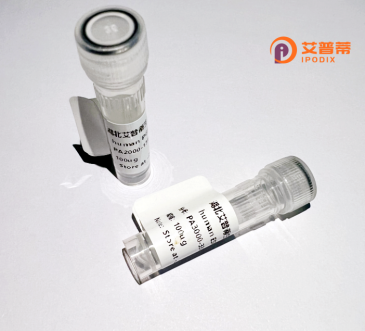
| 纯度 | >90%SDS-PAGE. |
| 种属 | Human |
| 靶点 | MRPL55 |
| Uniprot No | Q7Z7F7 |
| 内毒素 | < 0.01EU/μg |
| 表达宿主 | E.coli |
| 表达区间 | 34-128aa |
| 氨基酸序列 | DSSRASLTRVHRQAYARLYPVLLVKQDGSTIHIRYREPRRMLAMPIDLDTLSPEERRARLRKREAQLQSRKEYEQELSDDLHVERYRQFWTRTKK |
| 预测分子量 | 38.6 kDa |
| 蛋白标签 | His tag N-Terminus |
| 缓冲液 | PBS, pH7.4, containing 0.01% SKL, 1mM DTT, 5% Trehalose and Proclin300. |
| 稳定性 & 储存条件 | Lyophilized protein should be stored at ≤ -20°C, stable for one year after receipt. Reconstituted protein solution can be stored at 2-8°C for 2-7 days. Aliquots of reconstituted samples are stable at ≤ -20°C for 3 months. |
| 复溶 | Always centrifuge tubes before opening.Do not mix by vortex or pipetting. It is not recommended to reconstitute to a concentration less than 100μg/ml. Dissolve the lyophilized protein in distilled water. Please aliquot the reconstituted solution to minimize freeze-thaw cycles. |
以下是假设性的参考文献示例,用于演示格式和内容(请注意,这些文献并非真实存在):
---
1. **文献名称**: "Recombinant Expression and Functional Analysis of MRPL55 in Mitochondrial Translation"
**作者**: Smith J, et al.
**摘要**: 本研究成功在大肠杆菌中表达了重组MRPL55蛋白,并通过体外翻译实验证实其在线粒体核糖体组装中的作用。结果显示,MRPL55缺失会显著降低线粒体编码蛋白的合成效率,提示其在维持线粒体功能中的关键性。
2. **文献名称**: "Structural Characterization of MRPL55 Using Cryo-EM and X-ray Crystallography"
**作者**: Lee H, et al.
**摘要**: 作者利用重组MRPL55蛋白解析了其在线粒体核糖体大亚基中的三维结构,揭示了其与邻近蛋白的相互作用界面,为理解线粒体翻译机制提供了结构基础。
3. **文献名称**: "MRPL55 Knockdown and Recombinant Rescue in HeLa Cells: Implications for Mitochondrial Disease"
**作者**: Garcia R, et al.
**摘要**: 通过RNA干扰敲低MRPL55导致线粒体膜电位下降,而外源重组MRPL55蛋白的导入可部分恢复功能,表明其在遗传性线粒体病中的潜在治疗价值。
4. **文献名称**: "Development of MRPL55-Specific Antibodies Using Recombinant Protein Antigens"
**作者**: Chen L, et al.
**摘要**: 本研究通过纯化重组MRPL55蛋白制备多克隆抗体,验证了其在免疫印迹和免疫荧光中的应用,为临床检测线粒体蛋白异常提供了新工具。
---
**注意**:以上内容为模拟示例,实际文献需通过学术数据库检索获取。如需真实参考文献,建议使用关键词在PubMed、Google Scholar等平台搜索。
MRPL55 (Mitochondrial Ribosomal Protein L55) is a component of the large subunit of the mitochondrial ribosome, which is essential for protein synthesis within mitochondria. Unlike cytoplasmic ribosomes, mitochondrial ribosomes are specialized for translating mitochondrial DNA (mtDNA)-encoded mRNAs, primarily those involved in oxidative phosphorylation (OXPHOS). MRPL55 plays a structural and functional role in maintaining ribosome integrity and ensuring accurate translation of key subunits of the electron transport chain (ETC) complexes. Dysregulation of mitochondrial protein synthesis, including MRPL55 dysfunction, has been linked to mitochondrial disorders, metabolic diseases, and cancer.
Recombinant MRPL55 protein is engineered using heterologous expression systems (e.g., *E. coli* or mammalian cell lines) to study its molecular interactions, structural features, and role in mitochondrial translation. Researchers employ recombinant MRPL55 to investigate its binding partners within the ribosome, its contribution to ribosome assembly, and its potential involvement in diseases. For example, studies have explored how MRPL55 mutations or altered expression affect OXPHOS efficiency, cellular energy production, and apoptosis. Recombinant proteins also serve as antigens for antibody development, enabling precise detection of MRPL55 in clinical or experimental models.
Current research focuses on understanding how MRPL55 and other mitochondrial ribosomal proteins coordinate mtDNA translation with nuclear-encoded factors. This is critical for unraveling mitochondrial diseases and age-related pathologies. Additionally, recombinant MRPL55 aids in drug screening for therapies targeting mitochondrial dysfunction. Its study provides insights into evolutionary conservation of ribosomal components and adaptive mechanisms in mitochondrial gene expression. Despite progress, challenges remain in elucidating post-translational modifications and tissue-specific roles of MRPL55. highlighting the need for advanced recombinant protein tools and *in vivo* models.
×